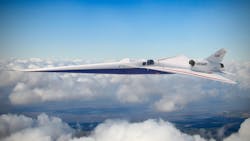Lockheed Martin’s supersonic X-59 could transform everything
BETHESDA, Md., - Commercial travel at supersonic speeds has been something of a wild goose chase. There are a number of technically challenging engineering obstacles that have to be overcome in order for a supersonic jet airliner to be both just possible—and importantly, commercially viable. Though difficult, there have been several supersonic jet airliners built, though they enjoyed varying degrees of success, Caleb Larson reports for The National Interest. Continue reading original article.
The Intelligent Aerospace take:
June 25, 2021 - The X-59 is shaped to reduce the loudness of a sonic boom reaching the ground to that of a gentle thump, if it is heard at all. It will be flown above select U.S. communities to generate data from sensors and people on the ground in order to gauge public perception. That data will help regulators establish new rules to enable commercial supersonic air travel over land.
Usually, engines are placed on the bottom of an aircraft, but on the X-59 this section of the inlet and engine are mounted to the top of the plane. This way supersonic shock waves from the inlet and engine are shielded by the wing — one of the many ways that NASA reduces the sonic boom to a sonic thump. With the engine’s unique location on the plane in mind, the team conducts high-speed wind tunnel testing to increase confidence that the inlet will work as designed.
After proving the aircraft works as designed and can fly safely in the national airspace, NASA will fly the X-59 over several participating communities across the country to understand their response to the X-59’s sonic thump. NASA will provide this data to federal and international regulators to enable them to consider setting new guidelines for the possibility of future supersonic commercial travel over land.
Related: NASA's experimental X-59 supersonic jet could be built by the end of 2020
Related: A view of NASA’s X-59 engine inlet
Related: NASA marks continued progress on X-59
Jamie Whitney, Associate Editor
Intelligent Aerospace
